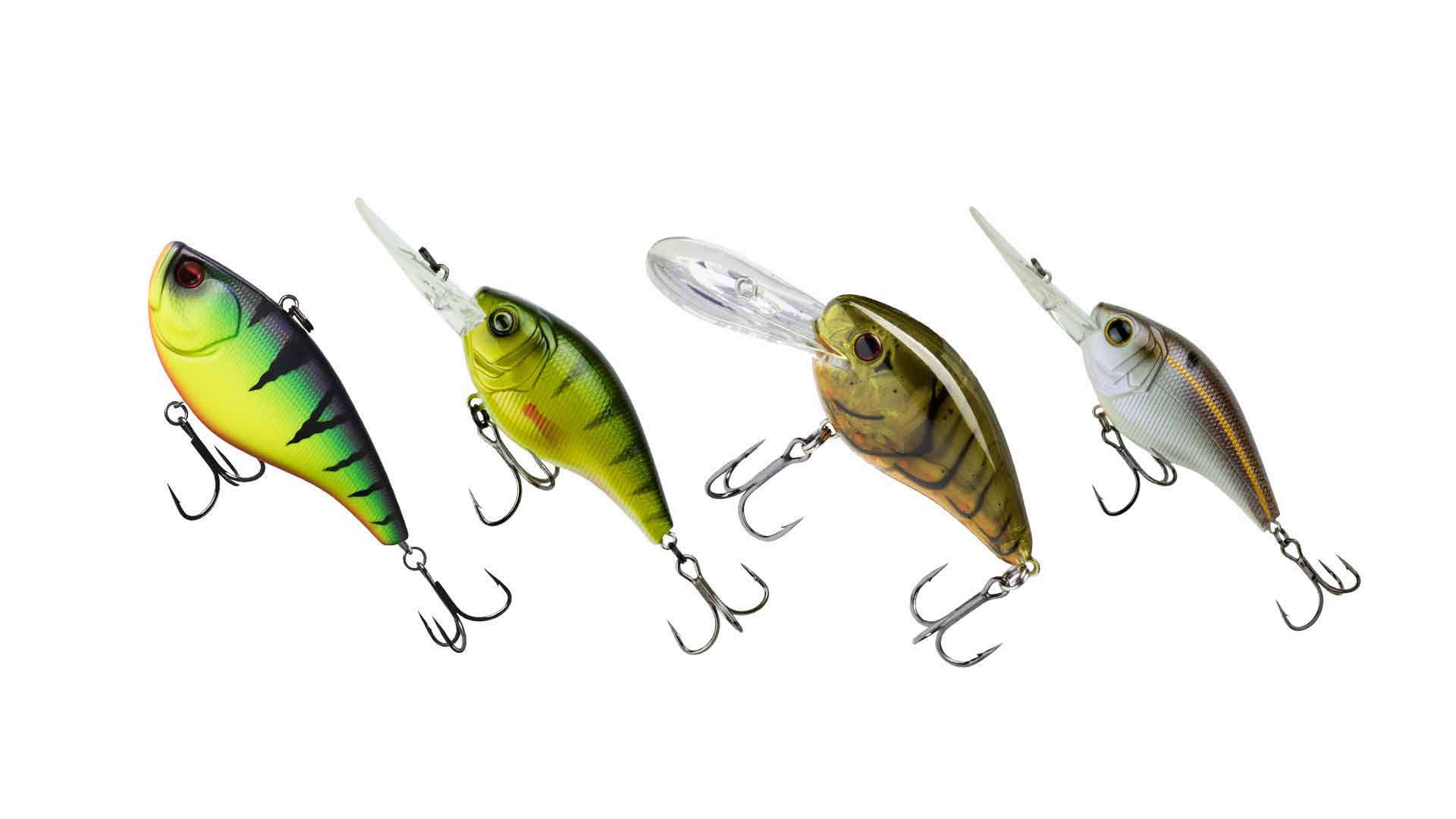Crankbaits have been a go-to lure for anglers for decades, thanks to their versatility and ability to attract a wide range of fish species. These lures are specially designed to mimic the erratic movements of baitfish, making them irresistible to predatory fish. In this guide, we will explore the nuances of crankbaits, including their types, applications, and advanced techniques. This information is based on the latest scientific research, insights from professional anglers, and a comprehensive review of various media sources.
The Science Behind Crankbaits
Crankbaits are unique in their design, featuring a hard body and a bill or lip that causes them to dive and wobble when retrieved. The shape and size of the bill play a crucial role in determining the lure’s depth and action. According to a study published in the “Journal of Fish Biology,” the vibration and sound produced by crankbaits can stimulate the lateral line system of fish, which is sensitive to changes in water pressure and movement. This makes crankbaits particularly effective in attracting fish, even in low-visibility conditions.
Detailed Types of Crankbaits
- Shallow-Diving Crankbaits: Designed for depths of 1 to 4 feet, these crankbaits are ideal for fishing in shallow water with abundant cover. Angler and TV host Bill Dance notes that shallow-diving crankbaits excel in early spring when fish are in shallow spawning areas. Their short, wide bills create a wide wobbling action that mimics the erratic movements of injured prey, making them effective for bass and other predatory fish.
- Medium-Diving Crankbaits: These lures can reach depths of 5 to 9 feet and are versatile for various fishing environments. They are particularly useful during transitional periods, such as the post-spawn season when fish move to mid-depth ranges. Renowned angler Kevin VanDam emphasizes the importance of matching the crankbait’s diving depth to the water’s depth to maintain optimal lure action.
- Deep-Diving Crankbaits: With the ability to dive beyond 10 feet, deep-diving crankbaits are perfect for reaching fish in deeper waters. Research from the “American Fisheries Society” suggests that fish often inhabit deeper, more temperature-stable environments during the summer and winter months. Deep-diving crankbaits can mimic the movements of deep-dwelling baitfish, making them highly effective for species like walleye and lake trout.
- Lipless Crankbaits: Characterized by their lack of a bill, lipless crankbaits rely on their shape and weight to sink and produce a tight wobbling action. These lures are highly versatile and can be fished at various depths. Angler and author Al Lindner recommends using lipless crankbaits in cold water conditions, where their subtle action can provoke strikes from lethargic fish.
Optimal Conditions and Strategies for Crankbait Fishing
Understanding the best conditions for using crankbaits can significantly enhance your fishing success:
- Seasonal Dynamics: Crankbaits are effective year-round, but their utility varies with the seasons. In spring, shallow-diving crankbaits are excellent for targeting bass in spawning areas. During summer, fish often move to deeper waters, making deep-diving crankbaits more effective. In fall, crankbaits can mimic baitfish that are feeding heavily in preparation for winter.
- Water Clarity: The clarity of the water is a critical factor in choosing the right crankbait. In clear water, natural colors like silver and green are more effective because they resemble the local forage. In murky water, bright colors such as chartreuse or fire tiger stand out better. According to fisheries biologist Dr. James Reynolds, the color of a crankbait can significantly impact its success, as fish rely on both sight and sound to locate prey.
- Habitat and Structure: Crankbaits are particularly effective around structures like rocks, submerged logs, and vegetation. The technique of “bumping the cover” involves retrieving the crankbait so that it bounces off these structures, creating erratic movements that trigger reaction strikes from fish. This method is especially useful for targeting species like pike, bass, and walleye.
Advanced Techniques for Crankbait Fishing
To maximize the effectiveness of crankbaits, anglers can employ several advanced techniques:
- The Steady Retrieve: This basic technique involves reeling in the crankbait at a consistent speed. It’s particularly useful when fish are actively feeding. The steady retrieve keeps the crankbait at a consistent depth, allowing it to maintain its action and attract fish.
- The Stop-and-Go: This technique involves pausing the retrieve intermittently, causing the crankbait to appear as if it’s a distressed baitfish. This sudden stop followed by a start can provoke predatory fish to strike. Anglers like Mark Zona use this technique in colder water, where fish are less likely to chase fast-moving prey.
- The Deflection Technique: One of the most effective ways to fish crankbaits is to make them deflect off structures like rocks and logs. This technique causes the crankbait to change direction suddenly, triggering a reaction strike from nearby fish. The deflection technique is especially effective for bass fishing, where it mimics the behavior of prey trying to escape predators.
- The Burn-and-Pause: This method involves a rapid retrieve, known as “burning,” followed by a sudden pause. The crankbait’s erratic movement, combined with the pause, can entice fish to strike. This technique is particularly effective in warm water when fish are more aggressive.
Choosing the Right Crankbait for Specific Scenarios
Selecting the right crankbait involves considering various factors, including the type of fish you’re targeting, the environment, and the time of year:
- Size and Shape: The size of the crankbait should match the size of the baitfish in the area. Larger crankbaits are generally better for targeting larger fish, while smaller crankbaits can attract a broader range of species. The shape of the crankbait can also influence its action, with round-bodied crankbaits offering a wider wobble and flat-sided crankbaits providing a tighter action.
- Color Patterns: The choice of color is critical in crankbait fishing. In clear water, natural colors like shad, bluegill, or crawfish patterns work well. In murky water, opt for bright and opaque colors. A study by the American Fisheries Society found that fish are more likely to strike lures that closely match the color and size of their natural prey.
- Sound and Vibration: Some crankbaits are equipped with rattles that produce sound and vibration as they move through the water. These features can be particularly useful in murky water or low-light conditions, where fish rely more on their lateral line—a sensory organ that detects movement and vibration.
Maintenance Tips for Crankbaits
Proper maintenance is crucial for prolonging the life of your crankbaits and ensuring they remain effective:
- Inspection: Regularly check your crankbaits for signs of wear and tear, such as chipped paint, bent hooks, or cracked bills. Damaged crankbaits can lose their effectiveness and may even scare away fish.
- Cleaning: After each use, especially in saltwater environments, rinse your crankbaits with fresh water to remove any dirt, salt, or debris. This will help prevent corrosion and maintain the lure’s finish.
- Storage: Store your crankbaits in a tackle box with individual compartments to prevent them from tangling or getting damaged. Consider using a tackle box with a desiccant to absorb moisture and prevent rust.
Conclusion: Mastering the Art of Crankbait Fishing
Crankbaits are an invaluable tool for any angler, offering a level of versatility and effectiveness that is hard to beat. Whether you’re fishing in shallow, medium, or deep waters, crankbaits can be tailored to meet the specific needs of any fishing scenario. By understanding the different types of crankbaits, the optimal conditions for their use, and the various techniques for fishing them, you can significantly improve your chances of success on the water. At BaitBeast, we offer a wide range of crankbaits to suit every angler’s needs. Equip yourself with the right gear and techniques, and take your fishing adventures to the next level.


 baitbeast.com
baitbeast.com baitbeast.com
baitbeast.com
Leave a Reply
Want to join the discussion?Feel free to contribute!